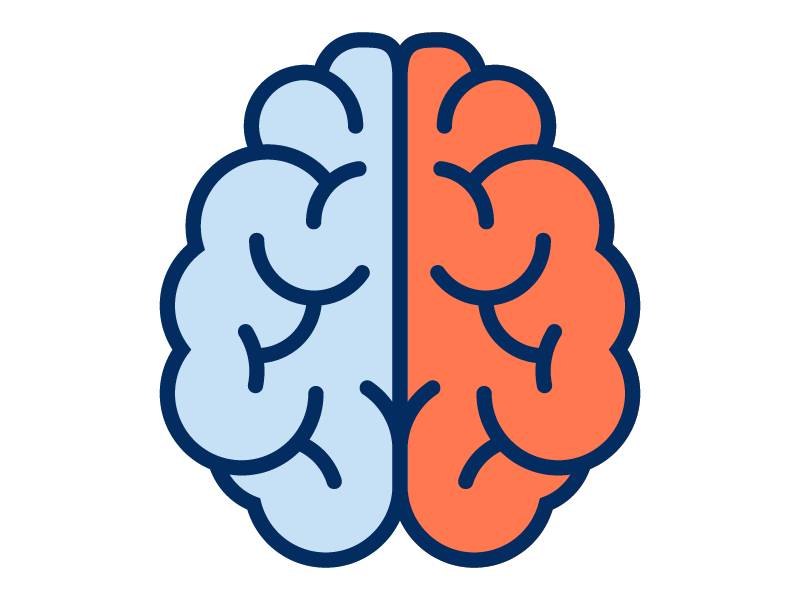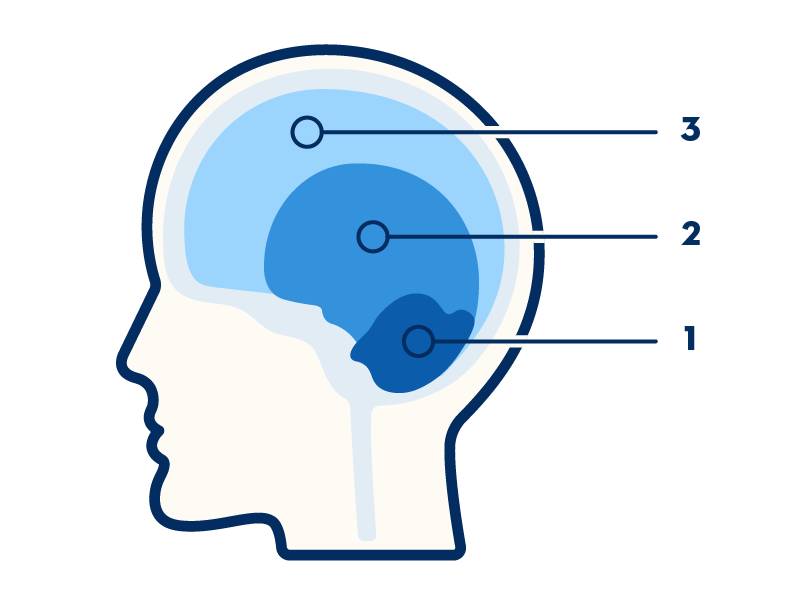Explore the Four Elements of Emotional Intelligence
Learning Objectives
After completing this unit, you’ll be able to:
- Explain the benefits of emotional intelligence.
- Define the four elements of emotional intelligence.
- Practice the 6-second rule to regulate your emotional response to challenging situations.
Get Started with Emotional Intelligence
In this module, you learn what emotional intelligence (EI) is and how improving self-awareness and self-management can help you be more successful. Throughout, you find several exercises and reflections developed by Arizona State University (ASU), designed to help you practice and become more aware of your EI.
What Is Emotional Intelligence?
Over time, there has been a cultural focus on the left side of the brain—the analytical, rational, logical side. This is especially true in business. As humans, however, we are not only rational, logical beings—we’re also emotional, creative, and artistic.
The emotional, creative, and artistic aspects are governed by the right side of the brain. Each side controls different aspects of who we are, so it makes sense to bring those two sides into some form of balance. 
Developing your understanding and application of EI skills does not mean that you will suddenly find yourself in a workplace filled with disruptive displays of emotion. It’s about being more aware of the other half of your brain, and how it impacts you. It's about recognizing your emotions and expressing them appropriately. And it's about becoming more open to what is happening to others and demonstrating genuine empathy for them.
Know the Four Elements of EI
EI can be broken down into four essential elements, per this handy table. We dive deeper into self-awareness and self-management in this module. You learn about empathy and skilled relationships in the next badge, Relationship Building.
| EI Element | Description |
|---|---|
|
Self-Awareness |
The ability to read and understand your emotions, and recognize their impact on work or relationships. |
|
Self-Management |
The ability to keep disruptive emotions and impulses under control, to maintain standards of honesty and integrity, and to maintain flexibility in adapting to change. |
|
Empathy |
The ability to recognize and understand others’ emotions, and take active interest in their concerns. |
|
Skilled Relationships |
The ability to inspire and guide groups or individuals, and to help develop others through feedback and guidance. |
Know the Benefits of EI
Developing your EI can help you become a more effective team member and leader. EI helps you build quality relationships where you can feel free to be open, creative, innovative, and supportive of others to be the same way.
Whatever your gender, race, or national origin, you can benefit from developing your EI. But we don’t recommend trying to tackle all four elements at once. Instead, start by focusing on the aspects of EI you feel you need to develop.
Reflection: Where Should I Start?
This first reflection is designed to help you pause and think about where you are on your EI journey. This module may be your first encounter with the topic of EI. Or maybe you’ve given it some thought already and you have an idea of what you should focus on. As you learn later in this module, pausing and thinking about your current situation has a number of benefits.
For this reflection, go ahead and rank the EI elements you learned about above, in order of your personal priority. What do you want to work on first? Drag the elements from the left into the ranking on the right, with 1 being the highest priority for you, 4 being the lowest.
This reflection is optional. But it can help you think about how you engage with EI in the workplace and give you a starting point to come up with ways to improve, based on challenges you may be facing. Once you've rated your priorities, you can click Submit, then Print. Choose whether to save your reflection as a PDF or print your ranking for review later if you want. We do not save your answers.
Learn How the Amygdala Can Hijack Control of Your Response to a Situation
Think about the moment when you’re about to give a presentation in front of a large crowd. Or think about when you get feedback that sounds like you didn’t perform as well as you thought you did. Sometimes, we have an emotional response to these kinds of events that can be overwhelming.
This emotional reaction comes from one part of the brain. A different part of the brain is responsible for thinking about the situation and coming up with the appropriate response.

- Automatic/first brain (primitive or reptilian). This part of the brain functions automatically, without thought, and even while we’re sleeping.
- Limbic brain (old mammalian). This is the part of the brain that enables learning, stores emotions, and records danger and fear.
-
Cortex and neocortex (rational, new mammalian). This part focuses on cognitive response, stores and analyzes information, and interprets data.
The amygdala resides in the limbic brain (2). It’s responsible for emotion and emotional learning. This is where you have your emotional response that can sometimes be immediate and overwhelming. Emotional responses can also be outsized compared to what you’re reacting to. When you have a sudden, overwhelming emotional response to something, we call that an “amygdala hijack.”
The amygdala is tricky, because it affects a system that acts independently from, and bypasses, the neocortex, which is responsible for rationality (3).
So what can you do to keep the amygdala in check?
Follow the 6-Second Rule
It generally takes 6 seconds for stimulus to move into the neocortex to counteract the amygdala. Follow these steps to help activate a balance between your emotion (amygdala) and your rationality (neocortex).
- Take a deep breath and count 6 seconds before you respond. This interrupts the amygdala.
- Observe your feelings and emotions.
- Ask yourself:
- What am I interpreting or making up?
- What are my intentions?
- Engage your neocortex by asking more questions based on the situation.
- Take action based on your observations.
The 6-second rule helps you foster self-awareness.
Find Your Balance
Learning how the brain works helps us to maximize the effectiveness of our rational, analytical brain functions and our emotional, intuitive brain functions. The result: a more complete human experience and the ability to consciously develop our leadership skills.
Self-awareness, skilled relationship-building, self-management, and empathy are increasingly recognized as essential qualities for dynamic leaders. The good news is, no matter our starting point, we can all develop these skills and improve our leadership abilities.
